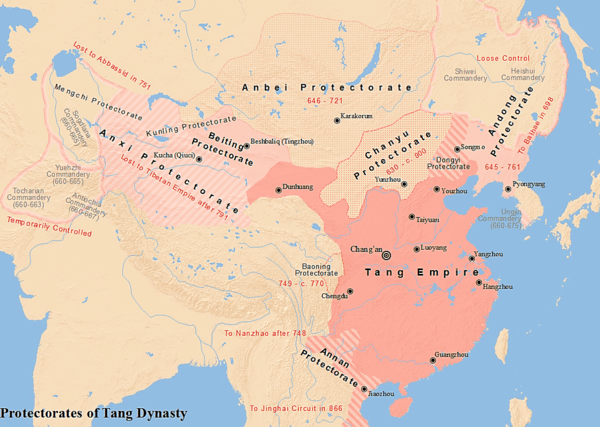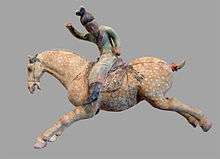Protectorate General to Pacify the North
| Protectorate General to Pacify the North | |
|---|---|
| Common name (669–757) | |
| Simplified Chinese: | 安北都护府 |
| Traditional Chinese: | 安北都護府 |
| Pinyin: | Anbei Duhu Fu |
| Wade-Giles: | Anpei Tuhu Fu |
| Alternate Name (647–663) | |
| Simplified Chinese: | 燕然都护府 |
| Traditional Chinese: | 燕然都護府 |
| Pinyin: | Yanran Duhu Fu |
| Wade-Giles: | Yenjan Tuhu Fu |
| Alternate Name (663–669) | |
| Simplified Chinese: | 瀚海都护府 |
| Traditional Chinese: | 瀚海都護府 |
| Pinyin: | Hanhai Duhu Fu |
| Wade-Giles: | Hanhai Tuhu Fu |
| Alternate Name (757–784) | |
| Simplified Chinese: | 镇北都护府 |
| Traditional Chinese: | 鎮北都護府 |
| Pinyin: | Zhenbei Duhu Fu |
| Wade-Giles: | Chenpei Tuhu Fu |
| History of Mongolia | ||||||||||||||||||||
|---|---|---|---|---|---|---|---|---|---|---|---|---|---|---|---|---|---|---|---|---|
|
Ancient period
|
||||||||||||||||||||
|
Medieval period
|
||||||||||||||||||||
|
Modern period
|
||||||||||||||||||||
|
| ||||||||||||||||||||
The Protectorate General to Pacify the North or Grand Protectorate General to Pacify the North (647–784) was a Chinese military government established by Tang Dynasty in 647 to pacify the former territory of Xueyantuo, which extended from Lake Baikal to the north, the Gobi Desert to the south, the Khingan Mountains to the east, and the Altay Mountains to the west. It controlled Mongolian Plateau from 647 to 682.
It was first established as Yanran at Shanyu Tai, southwest of present-day Urat Middle Banner, the northern slope of Lang Shan. This was later shifted to Hanhai and controlled by Uighurs instead of Han Chinese, around the banks of the Orkhon River, and named from its namesakes for a short period before it was changed to Anbei. The seat of governance remained there until the year 687.
History
In 646 the Tang dynasty conquered the Xuyantuo and on 9 January 647, 13 Tiele and Uyghur tribes surrendered to the Tang. Tang Taizong organized them into six commanderies and seven tributary prefectures under the Jimi system. The six commanderies were Hanhai (翰海府), Jinwei (金微府), Yanran (燕然府), Youling (幽陵府), Guilin (龜林府), and Lushan (盧山府). The seven prefectures were Gaolan (皐蘭州), Gaoque (高闕州), Jilu (雞鹿州), Jitian (雞田州), Yuxi (榆溪州), Dailin (蹛林州), and Douyan (竇顏州). Collectively these were known as the "Cantian Khan Circuit." On 10 April the Yanran Protectorate was created at the foothills of the Shanyu Plateau, southwest of present-day Urad Middle Banner, and governorship of the 13 tribes was handed over to the protector general, Li Suli (李素立), who served from 647-649.
On 5 February 663 the Yanran Protectorate was renamed Hanhai Protectorate.[1]
In August 669 the Hanhai Protectorate was renamed the Protectorate General to Pacify the North, otherwise known as the Anbei Duhufu.[2] Its seat was relocated to the city of Datong in present day Ejin Banner.
In 687 the seat of Anbei was moved to the city of Xi'an near modern Minle County due to incursions by the Second Turkic Khaganate.[2]
In 698 the seat was moved to Yunzhong near modern Horinger.[2]
In 708 the seat of Anbei was moved to the western Shouxiang city near modern Wuyuan County, Inner Mongolia.[2]
In 714 the Anbei and Chanyu protectorates were separated. Chanyu was re-located to Yunzhong while Anbei was re-located to the middle Shouxiang city, near modern Baotou.[2]
In 749 the seat was moved to the military settlement of Hengsai, near modern day Urad Middle Banner.[2]
Due to unfavorable farming conditions near the Hengsai settlement, Guo Ziyi resettled the army near modern Urad Front Banner in 755.[2]
Following the An Lushan Rebellion, the Chanyu and Anbei protectorates lost any real authority and survived in name only. Due to the taboo of An Lushan's name, the Anbei Protectorate was renamed the Zhenbei Protectorate in 757, which has the meaning of "Protectorate General to Suppress the North."[2]
In 758 the Hengsai Army changed its name to Tiande Army and came under control of the Zhenwu Jiedushi.[2][3]
In 840 a group of Uyghurs attacked the Tiande Army.[4]
In 843 the Chanyu Protectorate was renamed Anbei Protectorate[5]

List of protector generals
- Li Suli (李素立) 647-649
- Jiang Jian (姜簡)
- Ren Yaxiang (任雅相)
- Liu Shenli (劉審禮) 661
- Jiang Xie (姜協)
- Zang Shan'an (臧善安)
- Pang Tongfu (龐同福)
- Li Dazhi (李大志) after 672
- Sun Jun (孫俊) 694
- Li Dan, otherwise known as Emperor Ruizong of Tang (李旦) 699-702
- Zang Huailiang (臧懷亮)
- Wang Jun (王晙) before 714
- Li Sizhi (李嗣直)
- Zhang Zhiyun (張知運) around 716
- Zang Huaike (臧懷恪)
- Zang Xizhuang (臧希莊) 729
- Tian Wan (田琬)
- Li Guangbi (李光弼) 745-746
- Li Wan (李琬) 749
- Guo Ziyi (郭子儀) 749-754
- Li Linfu (李林甫)
- Zang Fangzhi (臧方直)
- Pugu Huai'en (僕固懷恩) 762
Jiedushi
- Li Zhongshun (李忠順) 843-845
- Qi Bitong (契苾通) 852-854
- Gao Chenggong (高承恭) 861-863
- Shi Shanyou (石善友) 893-903
- Li Cunjin (李存進) 923
See also
References
Citations
- ↑ Xiong 2008, p. 203.
- 1 2 3 4 5 6 7 8 9 Xiong 2008, p. 41.
- ↑ Xiong 2008, p. 679.
- ↑ Drompp 2005, p. 39.
- ↑ Xiong 2008, p. 82.
Sources
- Andrade, Tonio (2016), The Gunpowder Age: China, Military Innovation, and the Rise of the West in World History, Princeton University Press, ISBN 978-0-691-13597-7 .
- Asimov, M.S. (1998), History of civilizations of Central Asia Volume IV The age of achievement: A.D. 750 to the end of the fifteenth century Part One The historical, social and economic setting, UNESCO Publishing
- Barfield, Thomas (1989), The Perilous Frontier: Nomadic Empires and China, Basil Blackwell
- Barrett, Timothy Hugh (2008), The Woman Who Discovered Printing, Great Britain: Yale University Press, ISBN 978-0-300-12728-7 (alk. paper)
- Beckwith, Christopher I (1987), The Tibetan Empire in Central Asia: A History of the Struggle for Great Power among Tibetans, Turks, Arabs, and Chinese during the Early Middle Ages, Princeton University Press
- Bregel, Yuri (2003), An Historical Atlas of Central Asia, Brill
- Drompp, Michael Robert (2005), Tang China And The Collapse Of The Uighur Empire: A Documentary History, Brill
- Ebrey, Patricia Buckley (1999), The Cambridge Illustrated History of China, Cambridge: Cambridge University Press, ISBN 0-521-66991-X (paperback).
- Ebrey, Patricia Buckley; Walthall, Anne; Palais, James B. (2006), East Asia: A Cultural, Social, and Political History, Boston: Houghton Mifflin, ISBN 0-618-13384-4
- Golden, Peter B. (1992), An Introduction to the History of the Turkic Peoples: Ethnogenesis and State-Formation in Medieval and Early Modern Eurasia and the Middle East, OTTO HARRASSOWITZ · WIESBADEN
- Graff, David A. (2002), Medieval Chinese Warfare, 300-900, Warfare and History, London: Routledge, ISBN 0415239559
- Graff, David Andrew (2016), The Eurasian Way of War Military Practice in Seventh-Century China and Byzantium, Routledge, ISBN 978-0-415-46034-7 .
- Haywood, John (1998), Historical Atlas of the Medieval World, AD 600-1492, Barnes & Noble
- Latourette, Kenneth Scott (1964), The Chinese, their history and culture, Volumes 1-2, Macmillan
- Lorge, Peter A. (2008), The Asian Military Revolution: from Gunpowder to the Bomb, Cambridge University Press, ISBN 978-0-521-60954-8
- Millward, James (2009), Eurasian Crossroads: A History of Xinjiang, Columbia University Press
- Needham, Joseph (1986), Science & Civilisation in China, V:7: The Gunpowder Epic, Cambridge University Press, ISBN 0-521-30358-3
- Rong, Xinjiang (2013), Eighteen Lectures on Dunhuang, Brill
- Shaban, M. A. (1979), The ʿAbbāsid Revolution, Cambridge: Cambridge University Press, ISBN 0-521-29534-3
- Sima, Guang (2015), Bóyángbǎn Zīzhìtōngjiàn 54 huánghòu shīzōng 柏楊版資治通鑑54皇后失蹤, Yuǎnliú chūbǎnshìyè gǔfèn yǒuxiàn gōngsī, ISBN 957-32-0876-8
- Skaff, Jonathan Karam (2012), Sui-Tang China and Its Turko-Mongol Neighbors: Culture, Power, and Connections, 580-800 (Oxford Studies in Early Empires), Oxford University Press
- Wang, Zhenping (2013), Tang China in Multi-Polar Asia: A History of Diplomacy and War, University of Hawaii Press
- Wilkinson, Endymion (2015). Chinese History: A New Manual, 4th edition. Cambridge, MA: Harvard University Asia Center distributed by Harvard University Press. ISBN 9780674088467.
- Yuan, Shu (2001), Bóyángbǎn Tōngjiàn jìshìběnmò 28 dìèrcìhuànguánshídài 柏楊版通鑑記事本末28第二次宦官時代, Yuǎnliú chūbǎnshìyè gǔfèn yǒuxiàn gōngsī, ISBN 957-32-4273-7
- Xiong, Victor Cunrui (2000), Sui-Tang Chang'an: A Study in the Urban History of Late Medieval China (Michigan Monographs in Chinese Studies), U OF M CENTER FOR CHINESE STUDIES, ISBN 0892641371
- Xiong, Victor Cunrui (2009), Historical Dictionary of Medieval China, United States of America: Scarecrow Press, Inc., ISBN 0810860538
- Xue, Zongzheng (1992), Turkic peoples, 中国社会科学出版社
Further reading
- Ai, Chong. Tangdai Anbei Duhufu Qianxi Kaolun (A Study on the Change of Seats of the Anbei Protectorate During the Tang Dynasty). Journal of Shaanxi Normal University. 2001.4. ISSN 1000-5293.
- Li, Dalong. Youguan Tang Anbei Duhufu De Jige Wenti (On the Several Questions of the Tang Dynasty's Anbei Protectorate). Northern Cultural Relics. 2004.2. ISSN 1001-0483
- Wang, Jilin, "Anbei Duhufu" ("Protectorate General to Pacify the North"). Chinese Encyclopedia (Historiography Edition), 1st ed.
- Zhou, Weiyan, "Duhufu" ("Protectorate"). Encyclopedia of China (Chinese History Edition), 1st ed
- Xue, Zongzheng (1992). A History of Turks. Beijing: Chinese Social Sciences Press. ISBN 7-5004-0432-8. p. 404-429.
- Pulleyblank, Edwin G (2002). Central Asia and Non-Chinese Peoples of Ancient China. Aldershot: Ashgate Publishing. ISBN 0-86078-859-8. II, p. 35-42.
